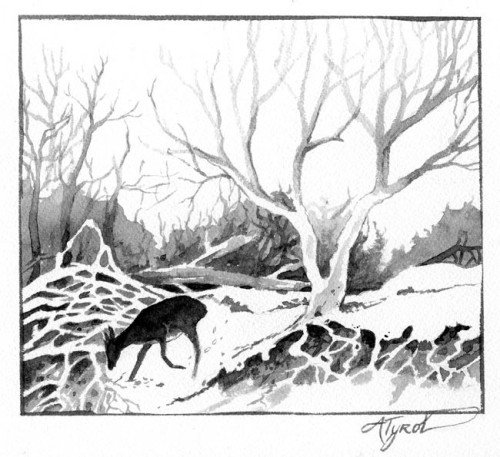
Last Sunday, I gave in. I hung my head, gassed up the chainsaw, and walked into the woods.
Not into deep woods, exactly, but to a spot on our hillside where a summer windstorm, hard on the heels of a logging job the winter before, had reduced trees to a tangle of uprooted stumps, decapitated trunks, and snapped limbs poking at threatening angles. Minus the smoke, the scene bore a passing resemblance to a war zone.
I know I shouldn’t admit this, but I was surrendering to internal pressure I’d been feeling for weeks. I felt compelled to go out and clean things up a bit.
There’s no justification for tidying up a woodlot. It’s generally bad for wildlife. In their ongoing search for food, water and shelter, animals would be finding all three in my messy woods. They had food from the raspberry and quaking aspen shoots growing thanks to the new opportunities for sunlight. In fall they were finding water in the potholes uphill of every blown-out stump, and, this winter, they could expect shelter from dead and dying trees. At least two species of woodpecker had begun carpentry projects on the damaged pines. Fisher, coyote and deer had visited the area as evidenced by their tracks etched in recent snowfalls.
There was no silvicultural justification for my chainsaw foray either, since, with the help of a professional logger, I had already salvaged all the potential sawlogs and firewood that had been smashed to the ground during that 15-minute blowdown last July. Part of the mess, indeed, was from the rotting butt logs and assorted slash left behind by the mechanical equipment. In the jargon of forestry, I had a perfectly good “early successional forest” on my hands—a nursery of young trees and sun-loving species that my otherwise middle-aged forest, quite frankly, was crying out for. I didn’t need to ask my forester to hear the advice she most assuredly would give: “Leave it alone.”
Nor could I claim to be improving recreational options. I’d long since cut the blowdowns off the trail and was back to my frequent walks through the heart of the disaster area on the loop familiar to our two dogs.
This is what got me into trouble, these regular walks through the devastation. It was hard enough looking at the twisted mess when it was just me and the dogs. Throw in an ever-changing cast of family and friends over the holidays, some squinting in surprise—and commenting—at the wreckage, and I felt the pressure.
“It’s not as bad as it looks,” I tried saying, and when this had little discernable effect, I would follow up with, “sometimes what looks bad can actually be good”, or, less convincingly, “this place is going to look great in a few years.” I could sense their thoughts: “Wow, if this guy’s the tree hugger, I’d hate to see the other guy.” I decided to clean things up, to keep up appearances.
So out I went, burning a few tank-fulls of chainsaw gas while felling snapped trunks, cutting small stumps to ground level, slicing masses of brush and trimming damaged saplings. I tried to restore order. I wanted things to look nice.
I know I’m not the only one who feels this desire to clean up the ‘yard.’ It’s a common compulsion in suburbia, where one is likely to find neatly trimmed trees, regularly spaced, with nary a shred of undergrowth or an untoward stick. Everything is in order to suggest security, if not lovely tranquility.
But orderliness in the woods is blight. To clean up is to transform something rich and diverse into something sterile. Many people clean their woods in hopes of seeing more wildlife; ironically, they’re chasing the wildlife away.
Psychologists would say the urge to tidy up the woods is primal – that it reflects our desire to eliminate the dark corners where danger might lurk, or that it expresses our desire to master our surroundings. That’s probably all true. One might also argue that the tendency to clean up is a suburban value, and having grown up in the suburbs, I know all about keeping up appearances.
The day after my tidying foray, and following a nice coating of overnight snow, I loosed the dogs and hiked out to inspect my hillside, with its nice fresh trimming. Good news: It still looked like hell. Two hours of solid effort, and gasoline emissions, for nothing. The project had been too big. All I saw now was a tangle of brush and debris, and, come to think of it, it was lovely. I noticed and took solace in the fresh tracks of a fisher and heard the chatter of chickadees, canvassing a dead birch I hadn’t had time to drop with my chainsaw.

